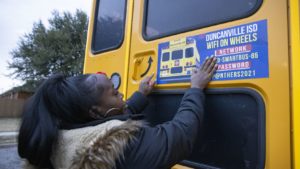 Abbott declares such access an emergency item as educators call for statewide strategy, not a patchwork of solutions
Abbott declares such access an emergency item as educators call for statewide strategy, not a patchwork of solutions
Taillights on a fleet of Duncanville buses lit up the roads early one morning just after the spring semester started. One turned onto Fouts Avenue and parked for the day as others passed by on their way to ferry students from their homes to the classroom.
The parked bus remained outside Renaissance Village Apartments for the next 10 hours, another kind of bridge between students and their school. It was among a handful of vehicles across southern Dallas County that broadcast Wi-Fi signals into nearby neighborhoods.
“There’s a lot of kids in Dallas that can’t afford the cable,” said busdriver Eugene O’Neil who manned his parked bus outside another Duncanville complex. “With this pandemic, they need access with their schooling online.”
Duncanville is one of many Texas school districts relying on band-aid solutions for the digital divide.
Schools around the state now regularly dispatch such internet-equipped buses to areas of their community with the lowest rates of online connectivity. Others extended Wi-Fi into parking lots. And some systems, like Dallas ISD, are building their own cell towers to boost signals from campuses into nearby neighborhoods.
It’s all part of short-term, patchwork solutions to serve families who either don’t have the internet or the money to acquire it.
Texas needs to invest in infrastructure and large-scale planning efforts to really address the gaps long-term, advocates say.
Gov. Greg Abbott named expanding broadband access as one of his five emergency items for this legislative session, which could make it more likely to be one of the few areas where lawmakers spend more money.
“From medicine to education to business, broadband access is not a luxury,” Abbott said. “It is an essential tool that must be available for all Texans.”
Advocates hope Abbott’s attention to this issue will result in strategic planning about how to improve access to broadband. Texas doesn’t have a statewide plan or office overseeing the effort.
Children across Texas are in need of a strong internet connection as about 45% of Texas public school students still were learning from home as of Oct. 30, according to the most recent information reported by the Texas Education Agency.
Stationing a bus outside an apartment complex for an entire school day isn’t a perfect solution, educators say. The internet could falter. A unit may be located outside the range, causing a student to learn from a parking lot to get a strong enough signal for a Zoom class.
“It makes it hard to learn. It makes it hard to stay current. It makes it hard to do all of your work that under normal circumstances is so routine,” Duncanville Superintendent Marc Smith said. “If they’re not able to maintain those connections and that engagement with their teacher, a lot of times we’ll see students just checking out.”
Education commissioner Mike Morath recently noted at last month’s State Board of Education meeting that the first phase of the Operation Connectivity plan is “basically done” with Texas and its schools purchasing 4.5 million devices, including laptops, tablets and hotpots.
But board member Audrey Young pointed out that devices aren’t always the answer. Her district-provided hotspot, for example, didn’t work in the middle of Davy Crockett National Forest, west of Lufkin.
Morath noted that the next two parts of the plan will be more challenging as the state must now address areas where there is no internet infrastructure and the barriers that prevent people from subscribing where infrastructure does exist.
“Both phase two and phase three will necessitate action in the Legislature as part of a big plan for broadband generally, not just for public education,” Morath said.
The governor’s Broadband Development Council, a group established by the Legislature in 2019, estimated that as of July 2020, nearly 1 million Texans, or about 3.4%, don’t have home access to broadband. Rural Texans represent about 90% of that group.
Not having broadband access at home is “particularly problematic for those who need to attend school virtually, visit a doctor online, or work remotely, either due to the COVID-19 pandemic or other factors,” members of the council wrote late last year.
The council recommended Texas establish a statewide broadband office and plan during the 2021 legislative session. Having both would allow the state to pull more federal dollars to close the digital divide, according to the council.
The group found that Texas is one of six states that doesn’t have a statewide plan. Texas is also among a small group of states that don’t have a state agency or broadband office to oversee larger planning efforts, said Jennifer Harris, the state program director for Connected Nation Texas who also sits on the governor’s council.
Building capacity in planning is an important step, according to the Pew Charitable Trusts. The nonprofit studied how states were expanding internet access across the country and reported in March 2020 that an overseeing office coordinating large scale, statewide responses is often a best practice.
Such offices “are aware of everything that’s going on … broadband wise,” Harris said. “They’re able to look at all of the federal funding opportunities that are available and make sure that we’re actually taking advantage of those in Texas in the best way that we can.”
Without a statewide office studying how many people are disconnected, the responsibility to track the severity of the problem and educate the public about it falls to nonprofits like Connected Nation Texas.
Rep. Charles “Doc” Anderson (R-Waco), who has long advocated for better broadband access, says there is more momentum for legislative action this year.
“I’m optimistic,” Anderson said. “The pandemic unmasked this whole issue and folks now, they don’t roll their eyes anymore when you talk about broadband.”
The House passed a bill last session to create a broadband office, but the Senate never voted on the bill. Sen. Charles Perry, (R-Lubbock), filed a bill in November to establish such an office, and Harris anticipates more legislation will be filed in coming days.
Once the state addresses needed infrastructure, it will still be challenging to tackle the barriers that prevent many families from subscribing to internet services.
The 2019 American Community Survey reported 67.6% of Texas households subscribe to a fixed broadband service. That puts the state behind the national average of 70.8%.
Finances are often the biggest barrier, Morath acknowledged at the SBOE meeting. “Those are the harder problems to solve,” he said.
Anderson noted that an office charged with searching for more federal funding could address part of this problem. The state could use new federal funds for grants or assistance to families in need of monetary support to subscribe. It could also open up avenues for public-private partnerships, he said.
Until the state takes action, districts like Duncanville will continue to adjust services for students who don’t feel comfortable learning in person and don’t have a stable Wi-Fi connection at home.




0 Comments